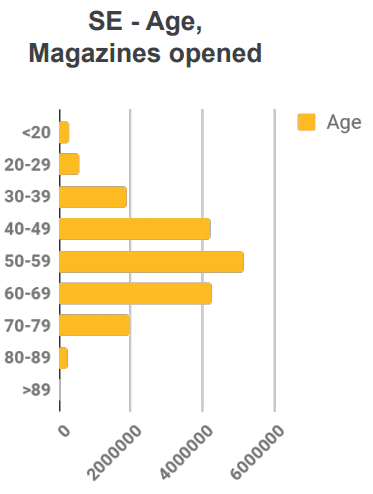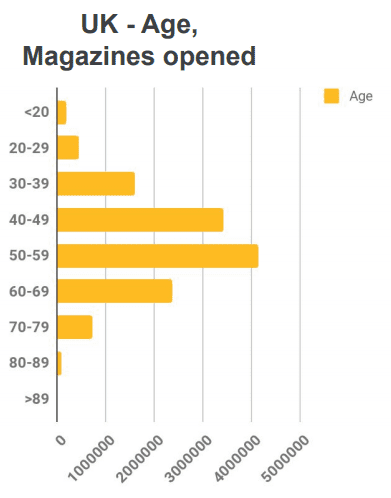|
Getting your Trinity Audio player ready...
|
‘All-you-can-read’ digital magazine app Readly has released its annual report into the trends, habits and insights of readers on its platform from the past 12 months.
The report reveals that across the 5,000 titles that are available on Readly in over 50 markets, digital issues were read 83 million times throughout 2019.
Although the findings are specific to the £7.99/month app, the report provides some fascinating insights into the habits of digital magazine readers around the world.
Here, we round up the most interesting findings, and what they mean for publishers with their own digital editions.
Time well spent
Of particular interest is the level of user engagement with the app. The total average time each subscriber spends with Readly is just under 7 hours a month, with the average user session being around 21 minutes. This is an impressive level of attention given the levels of demands on consumer time.
This dedicated engagement from users isn’t unique to Readly. Jonny Kaldor, CEO of digital publishing platform Pugpig, says that publishers are beginning to recognise the long-term value of apps as a way of deepening their relationship with readers.
“We have found that, while the web gives publishers access to a huge number of readers, it’s in their apps where we see the greatest engagement,” he explained. Many titles on Pugpig-powered apps are hitting over 25 minutes per session, and 15 sessions per month – similar levels of engagement to titles on Readly.
“We’re also seeing a significant uptick in publishers pursuing paid content strategies and switching to direct-to-consumer membership models,” said Kaldor.
Readly also included their data for when the most popular reading times are. Unsurprisingly, the bulk of time is spent in the evenings, concentrated particularly around 5-8pm. This suggests that users ‘lean back’ with the app at the end of the working day, when at home. At weekends, usage is spread much more evenly throughout the day.

The lesson for publishers here is that if the content is appealing and the reading experience is enjoyable, audiences are still willing to dedicate time to a digital magazine. Numbers will never be as high as online traffic, but apps offer a good opportunity to increase loyalty and add value for readers; something we at WNIP have discussed recently when looking at the growth of paid content apps from publishers.
Value in back issues
For publishers wondering whether anyone ever goes back through old issues, the answer from Readly’s data appears to be a resounding ‘yes’.
Readers in the UK have the highest rate of back issue reading, with older issues accounting for 16% of all issues read. Readly noted that subscribers in the UK are particularly committed to their favourite brands, and have seen ‘binge reading’ of back issues from some subscribers.
“Many subscribers are very committed to their favourite magazine brands and enjoy the content regardless of the publishing date,” said Readly’s Chief Content Officer Ranj Begley.
Nikki Simpson, Director of the International Magazine Centre, says that these figures are good news for publishers. “Magazine brands – across print, digital, events and more – are as relevant to readers as they’ve ever been,” she told WNIP. “The great thing about Readly is that all that evergreen content that hides away in many publishing houses is not only read, but monetised.”
There’s an opportunity here for publishers who don’t yet offer access to back issues. There’s clearly demand for them from super-users, and a number of publishers have found their archives have been a surprising way of appealing to younger audiences.
Devices define usage
One surprising fact from the report is the heavy skew towards tablet devices. Readly reports that mobile usage is growing steadily for the app, but tablets account for a whopping 86% of usage across regular readers, with little geographic variation.
On the one hand, this makes sense as many of the issues in the app are PDF replicas, which are notoriously difficult to read on a mobile phone. But it does also suggest there’s something of a ceiling for Readly, given that globally, tablet adoption has plateaued, especially among younger people.
However, as mobiles get larger and laptop-tablet hybrids grow in popularity, perhaps Readly will find a sustainable sweet spot with its magazine replicas. Its double digit growth in core markets last year is encouraging in this respect.
An ageing readership…in digital
The elephant in the room – or report in this case – is the age of Readly’s readers. Although they don’t provide an overall view of their users, the country snapshots of users who actively read the magazines consistently skew towards the older age brackets, with the majority of users between 40-69.


These numbers tell two stories. Firstly, older readers are by no means a negative trend. After all, they tend to have more disposable income, and established titles which they are already loyal to. It also demonstrates that these readers are growing more comfortable with the digital reading experience as a part of their daily lives.
However, it is the younger end where publishers are having difficulty attracting and retaining readers. Readly doesn’t appear to be an answer to this, and the idea of sitting back with a PDF replica doesn’t appear to be catching on with the under 40’s, which is problematic for long-term publisher strategies.
Although Readly haven’t revealed the number of people paying for a subscription, 1 million people worldwide have downloaded the app, and their subscriber base has “increased significantly” over the past year. The other figures in the report, including the 83 million digital issues read, is based on full paying subscribers and introductory offer trialists – all of whom have handed over money.
With numbers like that, it seems Readly is proving that the all-you-can-read Spotify-style model is viable, and that enough people will pay.



